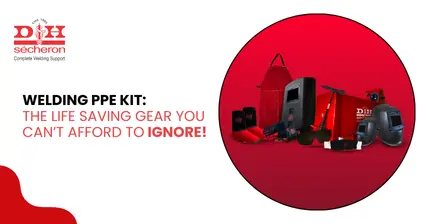All that You Need to Know About Welding Flux
The term flux, in the English language, means a continuous flow. In the world of welding, flux denotes a mixture of materials, typically carbonate and silicate. The key use of flux in welding is to protect the weld metal from contamination by atmospheric gases.
The flux ingredients are usually: calcium, calcium carbonate, calcium fluoride, magnesium, potassium and manganese oxides, sodium, silica, and aluminium oxide. The flux ingredients come together to help stabilize the arc and have more control over the mechanical properties.
What are the functions of Welding Flux?
- A shielding agent: The welding flux has a lesser density than the weld metal. Therefore, while welding, the welding flux melts and floats around the weld and deposits itself.
- Prevents oxidation: The welding flux, upon heating, produces gases that push back the atmospheric gases and prevents oxidation as well as any potential reactions that could occur with nitrogen.
- Creates slag for further shielding: The remains of welding flux solidify to create slag, which adds to the protection of the welded area.
- Usage as a coating in electrodes: Many forms of arc welding use welding flux, i.e, Shielded Metal Arc Welding (SMAW), Submerged Arc Welding (SAW), and Flux Cored Arc Welding or FCAW.
Use of Flux in Welding Processes
SAW
Submerged Arc Welding or SAW uses welding flux, also commonly known as SAW flux here, to provide the shielding properties mentioned above. SAW flux is usually granular in nature to provide higher deposition rates. The mechanical properties of the weld are also determined by the flux.
The SAW flux also controls the heat in while welding, which helps in concentrating the heat and furthering deeper weld penetration.
SMAW
Shielded Metal Arc Welding or SMAW uses solid core wires for its electrode. The welding flux is coated to the bare electrode by a process called extrusion. The coated electrode aids in arc striking, arc stability, and slag removal apart from the functions of the welding flux.
FCAW
Flux Cored arc Welding, as the name suggests, uses welding flux as a core part of its process. The flux-cored wire used in this welding has flux at its core.
The flux-cored wires are further divided into gas-shielded and self-shielded. These are self-explanatory - the gas-shielded ones require additional shielding against atmospheric gases while welding. Other common subtypes of flux-cored wires include low alloy steel flux.
Flux-cored wire consumables have many benefits wherein they have high deposition rates and can be used in all welding positions. They result in stronger and cleaner welds when compared with other forms of welding. This makes Flux Cored Arc Welding ideal for welding outdoors, in windy conditions, and for welding contaminated materials with scale and rust too!
While there are many types of welding, which type of welding to be used is determined by the scale and nature of the project, the outcome required, and the welding positions suitable.
Never let the materials available be a deciding factor. All your welding materials and welding consumables are available at D&H Sécheron. Among the many welding products that D&H Sécheron has to offer, you can find many types of welding flux in our MAXFLUX range and Flux Cored Arc Welding at our website.
11 May 2025 | Welding
An In-Depth Exploration of Low-Alloy Steel: Your Comprehensive Guide
11 May 2025 | Welding
Nagpur - Bori - Tuljapur Road MSH-3 in Yavatmal District (Maharashtra)
11 May 2025 | Welding
Guidelines to Understand Gas Welding: Applications, Advantages & Disadvantages
11 May 2025 | Welding
3 Tips for Finding the Best Mild Steel Electrode for Your Application
11 May 2025 | Welding
How to Select the Right Welding Filler Wires for Stainless Steel Welding?
11 May 2025 | Welding
Building the Narendra Modi Stadium with Norma V and Autotherme-1 Electrodes
11 May 2025 | Welding
Low Alloy Steel Welding in a (PEB) Pre Engineered Building Structure
11 May 2025 | Welding
Welding Rods: Different Types and Tips for Properly Storing and Handling
11 May 2025 | Welding
Tips for Flawless Welds with Stainless Steel Electrodes: Pros and Cons
11 May 2025 | Welding
Exploring Applications and Benefits of Stainless Steel Welding Electrodes
11 May 2025 | Welding
Welding Basics: Joining Metals with Heat and Pressure - A Beginners Guide
11 May 2025 | Welding
Distinguishing Low-Alloy Steel from High-Alloy Steel: Understanding the Variations
11 May 2025 | Welding
Hard Facing Wire - Understanding the Process and Achieving Optimal Result
11 May 2025 | Welding
Exploring the Advantages of Stainless Steel Electrodes in Welding Applications
11 May 2025 | Welding
Weathering Steel vs. Traditional Steel: A Comparative Analysis of Performance
11 May 2025 | Welding
Choosing the Right Welding Rod: Why 6013 Electrodes Might Be Your Ideal Option
11 May 2025 | Welding
Why 7018 Electrodes Are Preferred for High-Strength Welds in Pipeline Construction
11 May 2025 | Welding
Filler Wire vs. Stainless Steel Filler Wire: Understanding the Key Differences
11 May 2025 | Welding
Exploring the Impact of Filler Material on Welding Quality and Durability
11 May 2025 | Welding
Choosing the Right Cast Iron Electrode for Different Welding Projects
11 May 2025 | Welding
Top Advantages of Cast Iron Electrodes for Industrial Welding Applications
11 May 2025 | Welding
Key Benefits and Challenges of Using TIG Welding in Industrial Projects
11 May 2025 | Welding
5 Reasons Why 7018 Electrode is the Gold Standard for Welding Professionals
11 May 2025 | Welding
Top 5 Advantages of Flux Cored Arc Welding for Heavy-Duty Applications.png)
11 May 2025 | Welding
Lotherme-601: A Game-Changer for Restoring Shoulder Pins in Heavy Machinery
11 May 2025 | Welding
How D&H Sécheron Helped Repair a Rotary Kiln’s Cooler Section with LoTherme 352
11 May 2025 | Welding
Piston Repair for Mining Industry: Cost-Effective Solutions with LoTherme 468.webp)







.jpg)








































.jpg)
.jpg)

.jpg)

.jpg)




.jpg)
.jpg)
.jpg)



.webp)
.jpg)
.jpg)
.webp)
.jpg)






















.png)



.webp)

.webp)
.webp)



